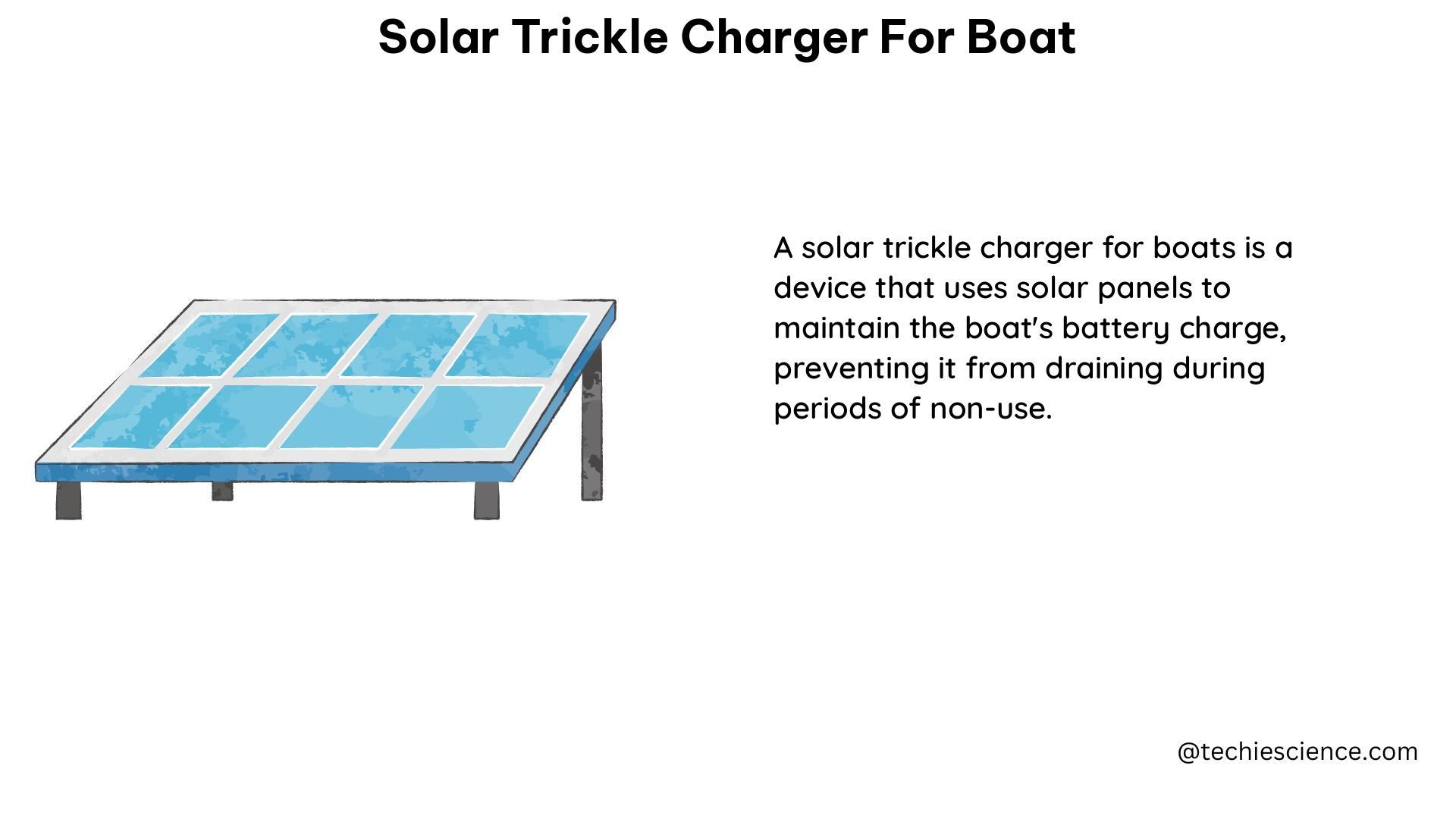A solar trickle charger for a boat is a device that uses solar energy to maintain the battery charge of a boat while it is not in use. These chargers are designed to provide a slow, continuous charge to the battery, preventing it from draining completely and extending its lifespan.
Understanding the Basics of Solar Trickle Chargers for Boats
Solar trickle chargers for boats work by converting the sun’s energy into electrical energy, which is then used to charge the boat’s battery. These chargers are typically designed to provide a small, steady flow of current to the battery, rather than a large, rapid charge.
The main components of a solar trickle charger for a boat include:
-
Solar Panel: The solar panel is the heart of the system, responsible for converting sunlight into electrical energy. The size and efficiency of the solar panel will determine the amount of power it can generate.
-
Charge Controller: The charge controller regulates the flow of electricity from the solar panel to the battery, preventing overcharging and ensuring the battery is charged efficiently.
-
Cables and Connectors: The cables and connectors are used to connect the solar panel to the charge controller and the charge controller to the battery.
Choosing the Right Solar Trickle Charger for Your Boat

When selecting a solar trickle charger for your boat, there are several factors to consider:
Battery Capacity
The first step is to determine the capacity of your boat’s battery, which is typically measured in amp-hours (Ah). This information will help you choose a solar trickle charger with the appropriate power output.
For example, if your boat has a 100Ah battery, you would need a solar trickle charger with a power output of at least 50W (100Ah / 2) to maintain the battery’s charge.
Solar Panel Size
The size of the solar panel is another important factor to consider. A larger solar panel will generate more power, allowing for a faster charge and the ability to maintain the battery’s charge even in low-light conditions.
Common solar panel sizes for boat trickle chargers range from 10W to 100W, with 20W and 50W being popular choices.
Charge Controller Capacity
The charge controller is responsible for regulating the flow of electricity from the solar panel to the battery, and its capacity should be matched to the size of the solar panel and battery.
A good rule of thumb is to choose a charge controller with a capacity of at least 20% more than the maximum output of the solar panel. For example, if you have a 50W solar panel, you would want a charge controller with a capacity of at least 60W.
Mounting and Portability
Depending on your boat’s layout and your needs, you may want to consider the mounting and portability of the solar trickle charger. Flexible solar panels, for example, can be easily mounted on curved surfaces, while portable panels can be easily moved around the boat.
Installing and Using a Solar Trickle Charger for Your Boat
Once you’ve selected the right solar trickle charger for your boat, the installation process typically involves the following steps:
-
Mount the Solar Panel: Secure the solar panel in a location on your boat that receives the most direct sunlight, such as the deck or the top of the cabin.
-
Connect the Charge Controller: Connect the solar panel to the charge controller using the appropriate cables and connectors.
-
Connect the Battery: Connect the charge controller to the boat’s battery using the appropriate cables and connectors.
-
Adjust the Charge Controller: Refer to the manufacturer’s instructions to adjust the charge controller settings, such as the charging voltage and current, to ensure the battery is charged efficiently.
-
Monitor the System: Regularly check the battery’s charge level and the solar trickle charger’s performance to ensure it is functioning properly.
Maintaining and Troubleshooting Your Solar Trickle Charger
To ensure your solar trickle charger continues to perform at its best, it’s important to perform regular maintenance and troubleshoot any issues that may arise.
Maintenance
- Clean the solar panel regularly to remove any dirt, debris, or shading that could reduce its efficiency.
- Check the connections between the solar panel, charge controller, and battery to ensure they are secure and free of corrosion.
- Inspect the charge controller for any signs of damage or wear and replace it if necessary.
Troubleshooting
- If the battery is not charging, check the connections and ensure the charge controller is functioning properly.
- If the solar panel is not generating enough power, check for any shading or obstructions and ensure the panel is positioned to receive the maximum amount of sunlight.
- If the charge controller is not regulating the charge properly, refer to the manufacturer’s instructions or consult a professional for assistance.
Conclusion
A solar trickle charger can be a valuable addition to your boat, helping to maintain the battery’s charge and extend its lifespan. By understanding the basics of these systems and following best practices for installation and maintenance, you can ensure your solar trickle charger provides reliable and efficient performance for years to come.
References:
- Solar Trickle Charger for Boat Batteries
- Solar Trickle Charger for Boat Batteries
- Solar Trickle Charger
- Trickle Charge Solar What Watt
- Solar Charging for Boat Batteries 24 Volt Trolling Motor

The lambdageeks.com Core SME Team is a group of experienced subject matter experts from diverse scientific and technical fields including Physics, Chemistry, Technology,Electronics & Electrical Engineering, Automotive, Mechanical Engineering. Our team collaborates to create high-quality, well-researched articles on a wide range of science and technology topics for the lambdageeks.com website.
All Our Senior SME are having more than 7 Years of experience in the respective fields . They are either Working Industry Professionals or assocaited With different Universities. Refer Our Authors Page to get to know About our Core SMEs.